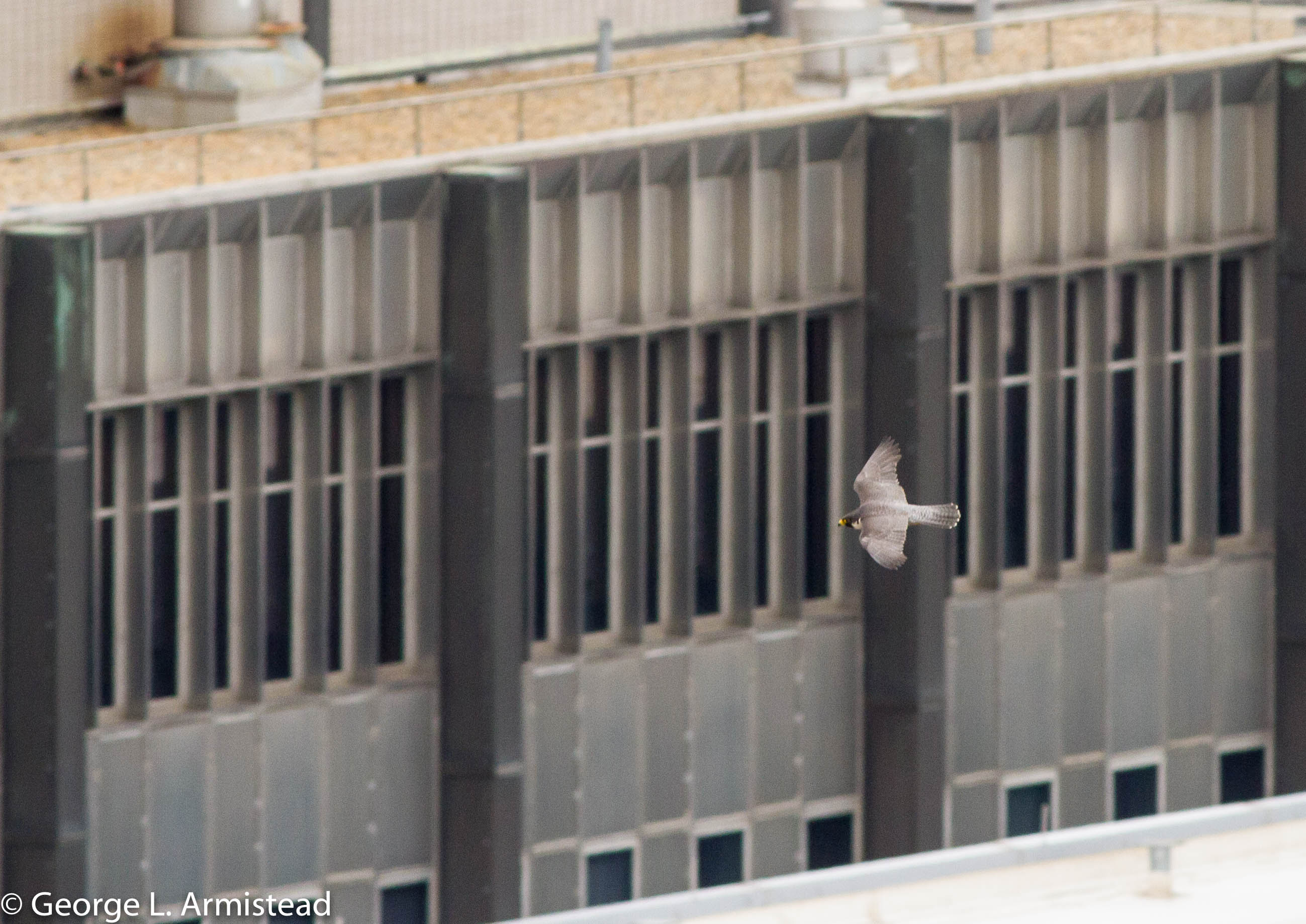Lights Out: Protecting migratory birds from illuminated skyscrapers

|
| This peregrine falcon is captured in flight in front of Philadelphia's City Hall. |
Contents |
[edit] Introduction
Architects often use glass to connect the inside and outside, but unfortunately it can literally kill the nature it attempts to put on display. In the UK, the British Trust for Ornithology estimates up to 30 million birds die every year from window strikes. In the US, up to a billion birds die each year when they collide with buildings, because they fly towards their bright, artificial lights turned on at night.
[edit] Night time illumination, skyscrapers and window strikes
Built up environments increasingly occupy or interrupt migratory routes, and artificial lighting inside these buildings can attract or confuse birds that migrate at night. Bird strikes typically increase during migratory seasons, as non-native species travel through towns and cities in unfamiliar landscapes.
These birds use natural cues - such as the earth’s magnetic field and the position of the stars - which is why artificial lighting on large panes of glass can be problematic for them. During cloudy weather, when natural cues may be obscured, birds may be even more attracted to artificial lighting.
Window strikes from birds can occur in skyscrapers when the large panes of glass act like mirrors. While strikes can happen at all levels of the building facade, they tend to happen most often in the levels comparable to those of the tree canopy.
For birds - whose eyes are positioned in such a way that makes it difficult for them to process visual information that is directly in front of them - this can create a misleading optical illusion of a clear passageway. Indoor plants and outdoor trees close to buildings can add to the confusion. Birds can die due to exhaustion brought about by disorientation.
[edit] Lights Out
In 1993, Toronto introduced the FLAP Canada programme which was the first initiative to address the problem created by lights in urban areas that were in the migratory paths of birds.
In 1999, Audubon introduced a Lights Out programme following monitoring of migratory bird strike data during the spring and fall. Those were times of year when artificial lights on at night (ALAN) and reflective and transparent glass had the most damaging effect on birds that migrate at night.
Lights Out was first introduced in Chicago and has since been adopted by cities throughout the US. In 2021, Philadelphia joined New York, Boston, Atlanta, Dallas, Cincinnati, Detroit, San Francisco and many other cities across the country.
The national initiative is a voluntary programme that involves turning off or blocking as many external and internal building lights as possible at night during migration seasons when birds are passing through the city by the millions. As part of the programme, property managers and their tenants are asked to turn off unnecessary lights between midnight and 6 a.m., especially in a building’s upper levels, lobbies and atriums, and to turn off or dim external lighting.
[edit] Related articles on Designing Buildings Wiki
- Birds and building collisions.
- Bird deterrent programmes.
- Light Pollution - Threat to Migrating Birds.
- Parleys Canyon Wildlife Bridge.
- Protected species.
- Spontaneous City at Cow Tower.
- Window.
- Window screens.
- Wired glass.
[edit] External resources
- Audubon, Lights Out.
- Flap Canada.
Featured articles and news
One of the most impressive Victorian architects. Book review.
RTPI leader to become new CIOB Chief Executive Officer
Dr Victoria Hills MRTPI, FICE to take over after Caroline Gumble’s departure.
Social and affordable housing, a long term plan for delivery
The “Delivering a Decade of Renewal for Social and Affordable Housing” strategy sets out future path.
A change to adoptive architecture
Effects of global weather warming on architectural detailing, material choice and human interaction.
The proposed publicly owned and backed subsidiary of Homes England, to facilitate new homes.
How big is the problem and what can we do to mitigate the effects?
Overheating guidance and tools for building designers
A number of cool guides to help with the heat.
The UK's Modern Industrial Strategy: A 10 year plan
Previous consultation criticism, current key elements and general support with some persisting reservations.
Building Safety Regulator reforms
New roles, new staff and a new fast track service pave the way for a single construction regulator.
Architectural Technologist CPDs and Communications
CIAT CPD… and how you can do it!
Cooling centres and cool spaces
Managing extreme heat in cities by directing the public to places for heat stress relief and water sources.
Winter gardens: A brief history and warm variations
Extending the season with glass in different forms and terms.
Restoring Great Yarmouth's Winter Gardens
Transforming one of the least sustainable constructions imaginable.
Construction Skills Mission Board launch sector drive
Newly formed government and industry collaboration set strategy for recruiting an additional 100,000 construction workers a year.
New Architects Code comes into effect in September 2025
ARB Architects Code of Conduct and Practice available with ongoing consultation regarding guidance.
Welsh Skills Body (Medr) launches ambitious plan
The new skills body brings together funding and regulation of tertiary education and research for the devolved nation.
Paul Gandy FCIOB announced as next CIOB President
Former Tilbury Douglas CEO takes helm.























